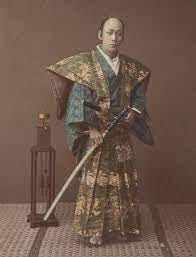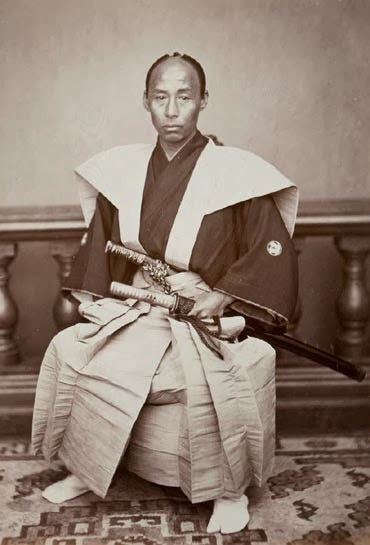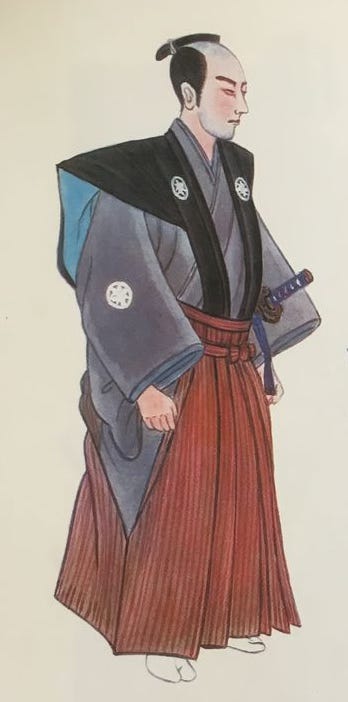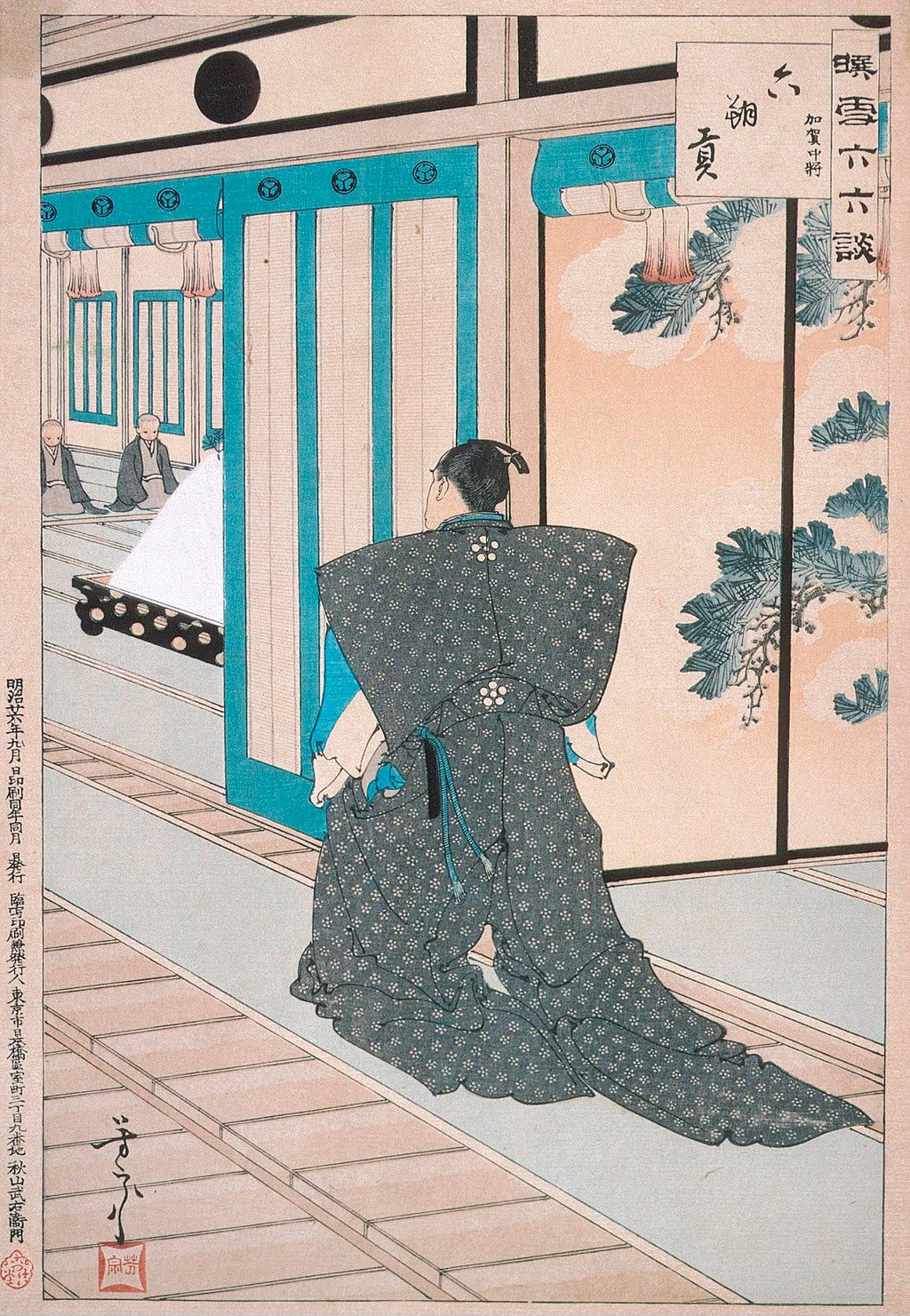Kamishimo is an iconic type of formal attire for men, particularly associated with the samurai class.
A kamishimo consists of a sleeveless upper garment called a kataginu, partially covering the upper body and hakama, pleated trousers, worn over a kosode (narrow sleeved kimono). In most cases, the kataginu and hakama are made from the same color and texture of fabric, with the family crest displayed on the central back and both sides of the kataginu front, as well as on the stiff backboard of the hakama. The hakama could be either the split baggy trouser-like umanori type, or the skirt-like andon type.The name originates from the fact that the upper kataginu and the lower hakama are made as a set. However, there are also tsugi-kamishimo in which the kataginu and hakama are different colors and even fabrics. These items of clothing originated during the Muromachi period (1336 to 1573), and by the Edo period was considered to be the official and formal wear of samurai. Townspeople and farmers often followed suit and wore it on ceremonial occasions, and as such kamishimo are still worn today in traditional performing arts and festivals.
Roots
Edo period nobles wore tsugi-kamishimo on a daily basis. It was originally written as 上下 (upper and lower), but during the Edo period it came to be written as 𧘕𧘔 and then adopted using a simplified 裃.
Kataginu do not have sleeves. Sleeveless clothing has been used since before the early modern period. However, these were standard work clothes for common people, made easier to move around in by removing the sleeves. Originally, the hakama was made from the same fabric, quality and color as the upper garments and was called kamishimo (upper and lower garments).


The origins of the combination of kataginu and hakama forming the kamishimo are unclear, but the Edo period historical book Seibyoshi records a legend that it began during the time of Shogun Ashikaga Yoshimitsu of the Muromachi Shogunate, when the sleeves and hems of plain court attire were tied up and worn in camp during field battles.
Warlords Matsunaga Hisahide and Konoe Sakihisa, are said to have developed the style, but this remains unproven, but it appears that the kataginu and hakama look had already become common around the time of Oda Nobunaga’s rise to power from around the 1560’s. Later, in the Edo period, the kataginu and hakama set came to be used as semi-formal attire in peacetime.
Originally it appears to have been constructed simply by removing the sleeves and chest straps from the plain outer court garments, and over time the front of the kataginu was made thinner with pleats, and worn with the hems tucked into the hakama back and front. Later, wider shoulders became fashionable, and during the Genroku period (1688 – 1704) the width of the fabric reached one shaku, or 30cm, at which point this measurement was fixed.
During the mid-Edo period, whale baleen or thin strips of bamboo were inserted to make the shoulders appear wider. In later years, the opposite trend of rounding the shoulders also became popular, and became known as ichimonji the straight line and hamaguri or cockle shell styles.
The wearers’ family crest was originally fitted to the outfit in six places, the center back and both sides of the kataginu at the breast, the koshi-ita backboard, and sleeves of the undergarment but in the Edo period the crests on the sleeves were omitted. The custom of wearing long hakama, or nagabakama as formal attire for daimyo and hatamoto of rank while at court In the Edo period was also developed and the colors also differed according to rank.

Traditionally kataginu were made of cotton, and kamishimo made of satin or damask were also commonly used, but later the fabric was exclusively linen (linen kamishimo called Tsu-suji were produced for samurai in Tsu, Mie Prefecture until the Meiji period). During the 1750’s, kamishimo with small patterns became popular, and a trend arose among the feudal lords visiting Edo Castle to compete with each other over the sophistication of their own small patterns. High ranked Samurai often wore order-made Kamishimo made of silk with raised patterns called Ryumon 龍紋.
Towards the end of the Edo period, haori overcoats and hakama replaced kamishimo as everyday clothing, and after the Meiji Restoration in 1868, public officials were banned from wearing kamishimo, but they are still worn today in traditional performing arts, festivals, and other events.
Types
Tsugi-kamishimo, in which the shoulder garment and hakama are not the same color or fabric is considered to be an even more informal style of formal dress than the han-kamashimo, but is rarely seen today. During the Edo period, even Kyoto nobles wore this tsugi-kamashimo in their daily lives.
Han-kamishimo, worn with normal length hakama have existed longer than the naga-kamishimo, worn with long, trailing hakama, but was considered less formal. Commoners wore han-kamishimo for ceremonial occasions, and in some feudal domains, it was used to indicate the rank of village officials.
With naga-kamishimo, the hakama (or naga-bakama) length was about 1.5 to three times longer than normal and covering the feet and trailed behind. It was considered even more formal than the half-sleeved kimono. Being able to walk properly in Naga-bakama was seen as a sign of fine lineage, and this type of costume was expected to be worn within the Shogun’s court. One reason for this was security. It was difficult to walk in, and therefore difficult to fight in. Anyone causing problems could be stopped easily by others by simply stepping on the train, tripping them over.
The flamboyant yet regal looking suit of upper, wide hempen wings and lower flowing pleats of the kamishimo over a knee length kimono remains an iconic image, and a unique fashion of the samurai.









